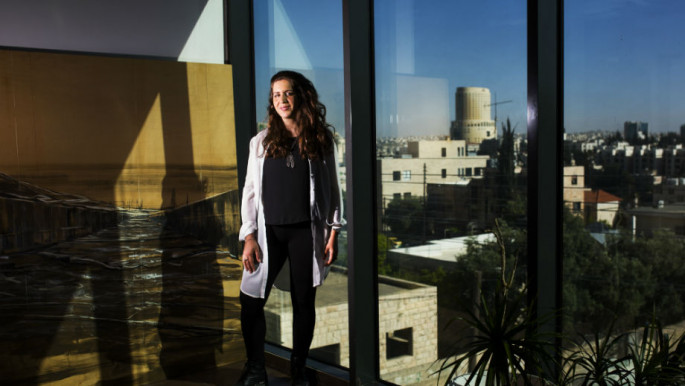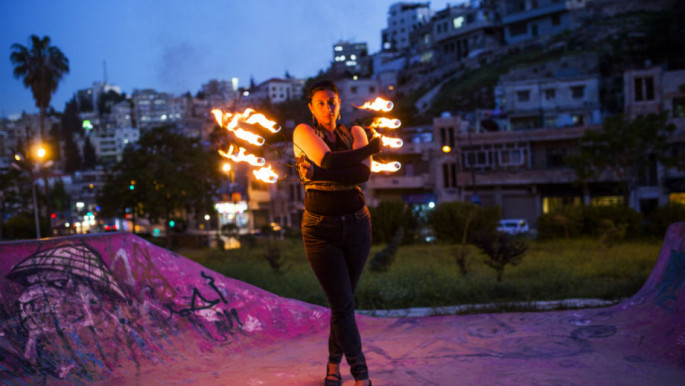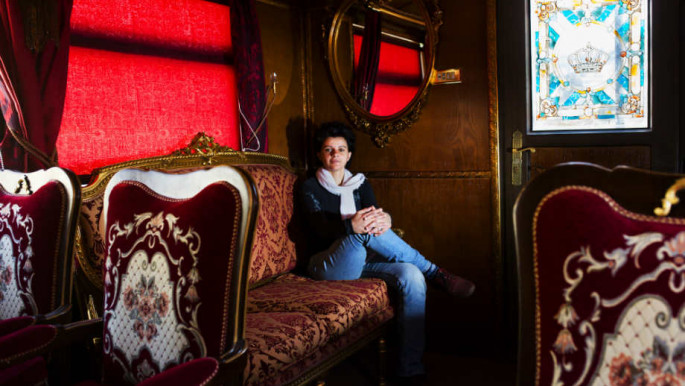The women shaping Amman
Dina Haddadin stands proud next to her two-metre paintings in her studio in Abdali, Amman. Her works are never any smaller.
"It is perceived as very aggressive, it is always double-sized, whatever paintings or installations, in a gallery or in the streets," Haddadin told The New Arab. "And I always got these comments from guys. These comments impacted me. But I loved also that they were surprised."
Dina Haddadin had always wanted to be an artist. It was clear in her mind that after school she would study art at the University of Jordan. But when her schooldays came to an end, her father told her that art was not a career, but a hobby - and so she had to choose "something that would fit better with her life".
Haddadin went on to study architecture, so she could feel close to the arts despite coming under a "professional" label. When she graduated in 2006, she started her art career and had the great fortune to attend art courses in New York in 2008.
She has always lived in Amman but her exhibitions have travelled to many countries and her artworks are displayed in museums in Dubai, Abu Dhabi, New York and London.
 |
| Architect Dina Haddadin blends her fields of expertise an an 'archetist' [Alessio Mamo] |
Working in the field of arts and architecture, she became known as an "archetist".
"But sometimes being a guy would be much easier," she said. "When I was pregnant, it was difficult and all the people were saying: 'Are you crazy, are you driving?'
 |
|
| Photoblog: The women shaping Amman Click here to meet more of the artists featured in this study with photos by the award-winning Alessio Mamo |
"It's much more difficult, but being a guy I could walk without hiding, and I could observe without being observed all the time."
Amman has always been a city of migrations and transitions. Every few decades, over hundreds of years, the evolving city has been transformed by flows of refugees: from the Circassians of the second half of the 19th century until the Syrians and Yemenis of the 21st century, passing by two different generations of Palestinians (Nakba and Naksa) and two Gulf Wars that displaced Iraqis.
Photoblog: The women shaping Amman - Meet more of the artists featured in this study with photos by the award-winning Alessio Mamo
All the consequent spatial transitions, site constructions, demolitions, marginal spaces, refugees camps of Amman and the power that dictates what is happening in the city form and shape the specific interest and research in the art of Dina Haddadin.
But Dina's commitment to the arts in the city's space is not an isolated case. While neighbouring countries are burning in turmoil and crisis, the so-called "Kingdom of Peace" lives in precarious stability - and the arts scene is growing.
 |
The message is that a wedding for a woman obliged to marry her rapist is the same as a funeral |  |
Women artists in Jordan often lead these changes, taking up spaces in a "male-dominated" society and challenging a mostly conservative patriarchal environment.
When the 29-year-old painter Rand Abdelnour organised her first solo exhibition two years ago, she turned her brush to tackle the issue of rape and raise awareness raised by the controversial article 308 of the Jordanian Penal Law. The article stated: "If a valid contract of marriage is made between the perpetrator (of rape), and the victim, the prosecution is suspended" - allowing the rapist to marry the victim.
Rand didn't know, while painting at that time, that in Summer 2017 that article would finally be abolished. Feminist associations and human rights organisations have long lobbied to cancel article 308 and the issue has always been at the top of their agenda. The accumulation of stories about "honour" killings, sexual violence, harassment and forced marriages, especially of young women, was bothering Rand's mind.
But to paint women's pain, she chose to dress them with the coloured patterns of the tents where the wedding takes place - and where the women meet their future husband.
"I used elements from our culture. When someone sees these tents, they immediately say: 'Oh there is a marriage!'" Abdelnur told The New Arab. "But the same pattern is dressed by a woman who is raped. It's a double punishment: first the rape, and then the marriage."
The woman who has been raped was never legally obliged to marry her rapist. Nevertheless, social pressure often made - and, beyond the law, still makes - the family decide on behalf of the daughter to marry the rapist to resolve an "honour affair".
Ironically, it's the same tent used for a funeral or a parliamentarian's election campaign.
Rand attempts to recount women's voices through the colours. "The message is that a wedding for a woman obliged to marry her rapist is the same as a funeral. I imagine that on the day of her marriage, she might prefer to die instead of marrying her rapist. In fact, this article punished instead of protecting women victims of violence and a long cultural battle has still to be won."
Those tents would eventually be where the same parliament members who refused for decades to change this article were elected.
"The people who can change the law are elected under the same patterns. I thought it was hypocritical and I wanted to show the contradictionm creating a camouflage, implying loss of identity due to oppression and abuse."
 |
| Photographer Linda Khoury, the founder of Jordan's international photography festival, pictured here in the first-class train wagon at the old Hijaz Railway Station [Alessio Mamo] |
Women artists in Jordan feed the cultural life of the capital city, founding independent arts spaces and creative initiatives. One name that comes up here is photographer Linda Khoury. The founder, curator and organiser of the longest photography festival in the Middle East, the Image Festival, lasting a month every April, with a great number of partners and artists, Linda's passion started when she was very young.
"The festival aims to gather more professionals, local and international, and create opportunities for cultural exchanges," says 38-year-old Khoury. "It involves the Jordanian audience more in the cultural and artistic realms through non-commercial photography."
 |
|
| Catch up with the world's largest collection of journalism focused on the fight for women's rights in the Middle East |
One of the Jordanian photographers featured was Tanya Habjouqa, with her women's collective, Rawiya, which also conquered international attention and awards with the long-term project "Occupied Pleasures" from Palestine.
Her first ambition was to found Darat al-Tasweer in Amman, the House of Photography, in order to push young photographers all over the country to pursue a professional career in photography.
Linda does not spend her time in the Darat: she often travels to the other regions to teach, through arts, how to challenge traditional gender roles.
"Outside Amman, it's even more difficult," Khoury told The New Arab. "Young boys always ask me if I am Christian, why I have short hair and all these kinds of questions. But photography helps to observe the world together and reimagine, reframe conservatively conceived gender roles."
Following other women artists, performing spaces, collective practices, urban and rural personal stories, and individual or collective artworks, Linda has over the past ten years created a vast network around her.
"It is not only about photography as a tool to document, it's more how art projects can involve society and social and cultural change."
And yes, the women in Amman are being influenced and are in turn influencing the rapidly modernising society which they occupy.
Marta Bellingreri is a freelance researcher and writer, with a PhD focused on gender studies in the Middle East. Follow her on Twitter: @MartaDafne
_
Click here to meet more of the creative women shaping Amman in this study, with this photo essay from the award-winning photographer Alessio Mamo.





 Follow the Middle East's top stories in English at The New Arab on Google News
Follow the Middle East's top stories in English at The New Arab on Google News


